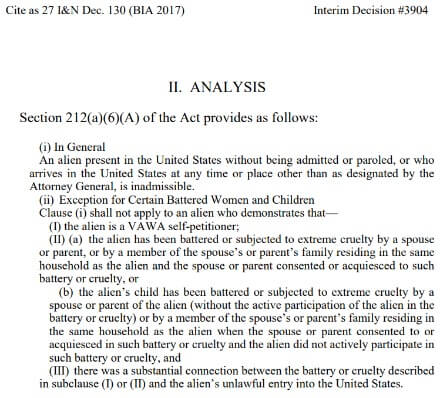- Introduction: Matter of Pangan-Sis, 27 I&N Dec. 130 (BIA 2017)
- Factual and Procedural History: 27 I&N Dec. at 130
- Relevant Statutes: 27 I&N Dec. at 131
- Issue: 27 I&N Dec. at 131
- Immigration Judge’s Reasoning and DHS Position: 27 I&N Dec. at 131-32
- Analyzing the Language of the Statute and Legislative History: 27 I&N Dec. 132-34
- Analysis of Scope of Exception and New Rules: 27 I&N Dec. at 135
- Rejecting the Immigration Judge’s Reading: 27 I&N Dec. 135-36
- Board’s Conclusion: 27 I&N Dec. at 136-37
- Conclusion
Introduction: Matter of Pangan-Sis, 27 I&N Dec. 130 (BIA 2017)
On October 6, 2017, the Board of Immigration Appeals (BIA) issued a published decision in the Matter of Pangan-Sis, 27 I&N Dec. 130 (BIA 2017). The decision addresses the scope of section 212(a)(6)(A)(ii) of the Immigration and Nationality Act (INA), which provides for a limited exception to section 212(a)(6)(A)(i). Section 212(a)(6)(A)(i) renders inadmissible an alien who is present in the United States without being admitted or paroled or who arrives in the United States at any time or place other than as designated by the Secretary of Homeland Security. Under section 212(a)(6)(A)(ii), an exception to inadmissibility is allowed for certain Violence Against Women Act (VAWA) self-petitioners who can establish a connection between their abuse and their unlawful entry into the United States. In Matter of Pangan-Sis, the Board held that an alien must satisfy each of the three subclauses of section 212(a)(6)(A)(ii) of the INA in order to be eligible for the exception. Notably, this includes subclause (I), which specifies that the alien must be “a VAWA self-petitioner.”
In this article, we will examine the facts and procedural history of Matter of Pangan-Sis and what the decision means going forward. Please see the full selection of articles about VAWA on our website to learn about VAWA relief in the immigration context.
Factual and Procedural History: 27 I&N Dec. at 130
The respondent was initially charged as removable for being inadmissible under section 212(a)(7)(A)(i)(I) of the INA for being in the United States without being in possession of a valid visa or entry document. The respondent conceded removability.
However, on November 5, 2014, the Department of Homeland Security (DHS) charged the respondent with removability under section 212(a)(6)(A)(i) of the United States for being present in the United States without having been admitted or paroled. The respondent subsequently conceded removability on the amended charge on December 17, 2015. However, the Immigration Judge terminated removal proceedings on the same day after finding that the respondent was exempt from section 212(a)(6)(A)(i) in accord with section 212(a)(6)(A)(ii). The DHS appealed from the Immigration Judge’s decision to the BIA.
Relevant Statutes: 27 I&N Dec. at 131
The Board excerpted the relevant statutes at issue in the case as seen below:

First, we must understand the inadmissibility provision in section 212(a)(6)(A)(i). This inadmissibility provision attaches to an alien who is “present in the United States without being admitted or paroled, or who arrives in the United States at any time or place other than as designated by the [Secretary of Homeland Security].” Essentially, this inadmissibility provision is meant to address entry without inspection (EWI).
Section 212(a)(6)(A)(ii) sets forth a limited exception from 212(a)(6)(A)(i) that is applicable in what can generally be described as VAWA cases. Section 212(a)(6)(A)(ii) requires the alien to demonstrate certain facts in order to establish eligibility for the exception. This provision has three subclauses. Clause (I) requires that “the alien is a self-petitioner.” Clause (II) requires the alien to demonstrate that either he or she was battered or subjected to extreme cruelty by a specified individual. Clause (III) requires that the alien must establish “a substantial connection between the battery or cruelty described in subclause (I) or (II) and the alien’s unlawful entry into the United States.”
Issue: 27 I&N Dec. at 131
The issue before the Board on appeal was whether an alien who seeks to qualify for the exception found in section 212(a)(6)(A)(ii) must satisfy all three subclauses in order to qualify for the exception. In short, the effective issue is whether the victim of battery or extreme cruelty must also be a VAWA self-petitioner in order to qualify for the exception (in addition to showing a “substantial connection” between the battery or cruelty and the unlawful entry).
Immigration Judge’s Reasoning and DHS Position: 27 I&N Dec. at 131-32
The Immigration Judge concluded from the language of section 212(a)(6)(A)(ii)(III) that an alien need only satisfy either subclause (I) (being a VAWA self-petitioner) or subclause (II) (being a victim of battery or extreme cruelty by a specified individual (or parent of such victim who did not participate)). The Immigration Judge’s reasoning was that subclause (III) is written in the disjunctive. Specifically, subclause (III) requires the alien to prove a “substantial connection between the battery or cruelty described in subclause (I) or (II) and the alien’s unlawful entry into the United States.” Emphasis added.
In the instant case, the respondent was not a VAWA self-petitioner, meaning that she could not satisfy subclause (I). However, the Immigration Judge read subclause (III) as requiring only that the respondent demonstrate either a “substantial connection between the battery or cruelty described in subclause (I)”, or a “substantial connection between the battery or cruelty described in … subclause (II). Thus, the Immigration Judge determined that, although the petitioner was not a VAWA self-petitioner, the respondent was eligible for the exception based on the fact that she had been abused by her Guatemalan citizen spouse and there was a substantial connection between that abuse and her unlawful entry.
The DHS read section 212(a)(6)(A)(ii) differently. It argued that an alien must satisfy all three subclauses of the provision in order to qualify for the exception. Under the DHS’s reading, being a VAWA self-petitioner is a prerequisite to being eligible for the exception from section 212(a)(6)(A)(i) inadmissibility. For this reason, the DHS argued that the respondent in the instant case was ineligible for the exception because she was not a VAWA self-petitioner.
The respondent agreed with the Immigration Judge’s reading of the statute. She argued that the statute itself was ambiguous because, while subclause (III) listed subclauses (I) or (II) in the disjunctive, there was no conjunction between subclauses (I) and (II). The respondent’s position was that the disjunctive in subclause (III) meant that she needed to only satisfy either subclause (I) or (II) and not subclauses (I) and (II).
As we noted above, the effect of the dispute is whether an individual must be a VAWA self-petitioner to qualify for the exception. Subclause (II), in the absence of subclause (I), would make the exception more widely applicable as evinced by the Immigration Judge’s ruling in favor of the respondent.
In the forthcoming sections, we will examine the Board’s reasoning in siding with the DHS’s position and reversing the Immigration Judge’s decision.
Analyzing the Language of the Statute and Legislative History: 27 I&N Dec. 132-34
The Board began by analyzing the language of section 212(a)(6)(A)(ii) itself. Citing to the decision of the United States Court of Appeals for the Ninth Circuit in Nadarajah v. Gonzales, 443 F.3d 1069, 1076 (9th Cir. 2006), quoting from K Mart Corp. v. Cartier, Inc., 486 U.S. 281, 291 (1988), the Board explained that in “ascertaining the plain meaning of the statute, [we] must look to the particular statutory language at issue” and must assess “the language and design of the statute as a whole.”
The Board explained that, as a matter of the normal principles of statutory construction, the use of the word “and” after subclause (II) and before subclause (III) would indicate that an alien must meet the requirements of all three subclauses in order to qualify for the exception. However, the Board noted that, while the structure of the statute is subclause (I), (II), and (III), subclause three itself refers to subclause (I) or (II), suggesting from that provision alone that an alien must meet the requirements of subclause 1 and (III). Because of the tension within the statute, the Board agreed with the respondent that the construction of the statute renders it ambiguous.
Citing to Matter of L-A-C-, 26 I&N Dec. 516, 518 (BIA 2015), the Board explained that it considers the legislative history when the language of a particular statute is unclear. Section 212(a)(6)(A)(ii) was added to the INA by section 301(c)(1) of the Illegal Immigration Reform and Immigrant Responsibility Act (“IIRIRA”) of 1996, Division C of Pub. L. No. 104-204, 110 Stat. 3009-546, 3009-578. The Board found that the legislative history of the IIRIRA “does not contain any explicit consideration of the statutory language in question…” However, the Board determined that, while the legislative history of the IIRIRA was not useful for its inquiry, the legislative history of VAWA was. In relying on the legislative history of VAWA, the Board cited to United States v. Lewis, 67 F.3d 225, 228-29 (9th Cir. 1995), wherein the Ninth Circuit held that phrases should be understood with respect to their purpose in the overall statutory scheme.
The Board explained that the battered spouse provision of VAWA attempted to remedy the fact that U.S. citizens and lawful permanent residents (LPRs) who petition for alien spouses have “considerable leverage over the foreign national spouse,” which made abused alien spouses reluctant to leave their petitioning abusers in many cases.
To further analyze VAWA, the Board assessed the legislative history of the earlier section 216(c)(4)(C) of the INA, which provides for waivers to the interview requirement to remove conditional permanent resident status based on marriage for those who entered a marriage in good faith and were battered or subjected to extreme cruelty by their U.S. citizen or LPR spouse or a member of the spouse’s family (also applies if the alien’s child was battered or subjected to extreme cruelty). Citing to a House Judiciary Committee report on the provision, the Board found that the report stated that the purpose of section 216(c)(4)(C) “is to ensure that when the U.S. citizen or permanent resident spouse or parent engages in battering or cruelty against a spouse or child, neither the spouse nor child should be entrapped in the abusive relationship by the threat of losing their legal resident status.” H.R. Rep. No. 101-723(I), at 78 (1990).
Subsequently, Congress passed VAWA in 1994. VAWA contains the VAWA self-petitioning provisions for battered spouses of U.S. citizens or LPRs, extending the relief that available to such victims. A House Judiciary Committee Report accompanying VAWA explained that the purpose of the self-petitioning provision was “to prevent the citizen or resident from using the petitioning process as a means to control or abuse an alien spouse.” H.R. Rep. No. 103-395, at 26, 37 (1993).
From the legislative history, the Board gleaned that Congress’s purpose in enacting the VAWA self-petitioning provision was “to protect vulnerable aliens from domestic abuse at the hands of a United States citizen or lawful permanent resident spouse.” The Board also determined that the Violence Against Women Act of 2000, Division B of Pub. L. No. 106-386, 114 Stat. 1491, continued the focus of the 1994 VAWA.
Analysis of Scope of Exception and New Rules: 27 I&N Dec. at 135
The Board determined that in light of Congress’ “consistent focus on preventing United States citizens and lawful permanent residents from using their status to abuse and control their alien spouses and children,” the best reading of section 212(a)(6)(A)(ii) of the INA is that an alien most demonstrate that he or she is described by all three subclauses of the statute instead of either subclause (I) or (II) in addition to subclause (III). Contrary to the Immigration Judge’s position, the Board determined that the disjunctive language in subclause (III) did not mean that the alien would have to establish only that he or she was described by subclause (I) or (II).
In accordance with its reading and after studying the legislative history, the Board read subclause (II) as “expand[ing] the protection for abused aliens to cover abuse committed not only by United States citizen and lawful permanent resident spouses and parents but also by members of the household where the abuser is acting at the direction of the United States citizen and lawful permanent resident.” In reading the disjunctive phrasing in subclause (III), the Board determined that “[t]he practical effect of this interpretation is that a spouse of a United States citizen or lawful permanent resident is also covered.” Emphasis added. However, the Board held that aliens who are married to individuals other than U.S. citizens or LPRs are not covered “because such persons lack ‘immigration leverage’ over their spouses.”
The Board rejected the respondent’s position that its reading rendered subclause (II) “superfluous.” The Board noted that, while the clauses have overlap, “there are significant differences between the clauses that cannot be overlooked.” Specifically, the Board noted that subclause (II), under its reading, “covers abuse that the alien may suffer after attaining VAWA self-petitioner status.” Furthermore, as the Board held above, subclause (II) covers abuse committed by members of a spouse’s or parent’s household, provided that the spouse or parent is a U.S. citizen or LPR and the spouse or parent is directing the abuse. The Board concluded that the “overlap” between subclauses (I) and (II) “reflects Congress’ intent to ensure that there would not be a gap in coverage for aliens who are abused by, or with the consent of, United States citizen or lawful permanent resident spouses or parents.”
Rejecting the Immigration Judge’s Reading: 27 I&N Dec. 135-36
The Board explained that the Immigration Judge’s position “would vastly expand the reach of the provision.” Specifically, it noted that the Immigration Judge’s reading of section 212(a)(6)(A)(ii) would remove any requirement that the abuser be a U.S. citizen or LPR, meaning it could “apply to any domestic abuse situation in the world.”
Regarding the facts of the instant case, the Board explained that the respondent alleged abuse at the hands of her Guatemalan spouse, who was neither a U.S. citizen nor an LPR. Referring to the purpose of VAWA, the Board explained that Congress’ purpose in enacting the provision was to prevent an alien from being subject to the complete control of a U.S. citizen or LPR spouse in order to gain permanent legal status, “not with creating an exception to a ground of inadmissibility for domestic abuse of an alien that takes place outside the United States.” The Board found it unlikely that Congress meant to create such a broad exception to section 212(a)(6)(A)(i).
The Board noted another peculiarity should it opt to follow the Immigration Judge’s approach. Under the Immigration Judge’s approach, an alien could qualify for the exception by only satisfying clauses (II) and (III). However, as applied to the respondent’s case, she would have been found to be not removable from the United States for entry without inspection while lacking any legal status in the United States despite not being inadmissible. The Board concluded that Congress could not have intended this result. Rather, the Board read the provision as existing to prevent the entry without inspection ground of inadmissibility from disqualifying a VAWA self-petitioner from eligibility to adjust status.
Board’s Conclusion: 27 I&N Dec. at 136-37
Because the Board determined that a respondent must satisfy all three clauses of section 212(a)(6)(A)(ii) to qualify for an exception from section 212(a)(6)(A)(i), the Board concluded that the Immigration Judge erred in terminating removal proceedings against the respondent because she was not a VAWA self-petitioner. The Board vacated the Immigration Judge’s decision and remanded the record for further proceedings.
Conclusion
The Board’s decision clearly limits the applicability of the section 212(a)(6)(A)(ii) exception to inadmissibility for entry without inspection to VAWA self-petitioners who satisfy all three subclauses. This reading is much more limited than the one adopted by the Immigration Judge. A victim of violence facing immigration issues should consult with an experienced immigration attorney for case-specific guidance as to whether VAWA or a different form of immigration relief may be available. Please see our Victims of Violence Immigration category to learn more about VAWA and other forms of relief for certain aliens who are crime victims.





